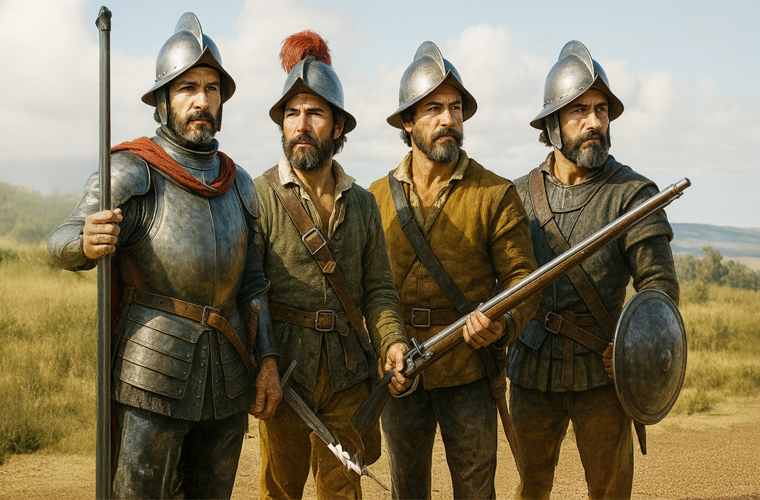The Spanish conquistadors were a formidable force in the Age of Exploration, shaping the course of history through their audacious expeditions across the Americas. Driven by a potent mix of ambition, religious zeal, and the promise of wealth, these adventurers spearheaded Spain’s rapid expansion into the New World during the 15th and 16th centuries. Their conquests led to the fall of mighty indigenous empires, the establishment of vast colonial territories, and profound cultural, social, and economic transformations that reverberate to this day. This article explores the origins, motivations, key figures, and lasting legacy of the Spanish conquistadors.
The era of the conquistadors emerged from a convergence of historical developments in Spain. By the late 15th century, the Reconquista—a centuries-long campaign to expel Muslim rulers from the Iberian Peninsula—had culminated in the unification of Spain under Ferdinand II of Aragon and Isabella I of Castile. The fall of Granada in 1492 marked the end of Muslim rule in Spain, freeing up resources and manpower for overseas exploration. That same year, Christopher Columbus, sailing under the Spanish crown, reached the Americas, igniting an era of discovery and conquest.
The conquistadors were typically minor nobles, soldiers, or adventurers from Spain’s emerging middle class, lured by the prospect of land, titles, and riches. They operated under a system of royal charters, or capitulaciones, which granted them permission to explore and conquer new territories in exchange for a share of the spoils. This arrangement aligned their ambitions with Spain’s imperial goals, creating a highly motivated cadre of explorers.
Motivations: Gold, Glory, and God
The conquistadors’ motivations are often summarized by the triad of “gold, glory, and God.” Wealth was a primary driver, as the New World promised gold, silver, and other resources. The discovery of vast silver mines, such as those at Potosí in modern-day Bolivia, fueled Spain’s economy and the conquistadors’ dreams of prosperity. Glory, too, was a powerful incentive—successful conquests could elevate a commoner to noble status, granting fame and influence. Finally, the Catholic Church played a central role, as conquistadors saw themselves as crusaders spreading Christianity to “heathen” lands, often justifying their actions with religious fervor.
Key Figures and Conquests
Several conquistadors left an indelible mark on history through their daring campaigns:
- Hernán Cortés (1485–1547): Cortés led the conquest of the Aztec Empire in 1519–1521. Landing on the coast of Mexico with a small force, he allied with indigenous groups opposed to Aztec rule, such as the Tlaxcalans, and marched on the capital, Tenochtitlán. Through a combination of military prowess, diplomacy, and smallpox (which devastated the native population), Cortés toppled the Aztec Empire, claiming Mexico for Spain.
- Francisco Pizarro (1478–1541): Pizarro conquered the Inca Empire in modern-day Peru during the 1530s. With just 180 men, he captured the Inca emperor Atahualpa at the Battle of Cajamarca, exploiting internal divisions within the empire. The subsequent looting of Inca gold and silver enriched Spain and solidified Pizarro’s legacy.
- Vasco Núñez de Balboa (1475–1519): Balboa was the first European to cross the Isthmus of Panama and reach the Pacific Ocean in 1513, claiming it for Spain. His discovery expanded Spain’s understanding of the New World’s geography.
- Juan Ponce de León (1474–1521): Known for his search for the mythical Fountain of Youth, Ponce de León explored Florida and established early Spanish settlements in the Caribbean.
These men, among others, operated in harsh conditions, often facing overwhelming odds against sophisticated indigenous civilizations. Their success relied on superior weaponry (steel swords, firearms, and horses), strategic alliances, and the unintended biological impact of European diseases.
Tactics and Technology
The conquistadors’ military advantage stemmed from their use of advanced technology and tactics. Steel armor and weapons outmatched the obsidian blades and cotton armor of many indigenous groups. Horses, previously unknown in the Americas, provided mobility and a psychological edge in battle. Cannons and arquebuses, though cumbersome, further tilted the odds. Additionally, the conquistadors exploited internal divisions among native peoples, forging alliances with rival factions to bolster their campaigns.
Impact and Legacy
The conquistadors’ actions had profound and often devastating consequences. The fall of the Aztec and Inca empires led to the destruction of complex societies, with millions dying from warfare, disease, and forced labor under the encomienda system, which granted Spanish settlers control over indigenous labor. The influx of gold and silver from the Americas transformed Spain into a global superpower, but also triggered inflation and economic instability in Europe.
Culturally, the conquistadors facilitated the spread of the Spanish language, religion, and customs, laying the foundation for Latin America’s Hispanic heritage. However, this came at the cost of indigenous cultures, many of which were suppressed or erased. The blending of European, indigenous, and African elements (due to the slave trade) gave rise to unique mestizo societies that define much of Latin America today.
The legacy of the conquistadors is deeply controversial. To some, they were bold explorers who expanded human knowledge and built an empire. To others, they were ruthless invaders responsible for immense suffering. Modern perspectives often grapple with this duality, acknowledging their historical significance while condemning the atrocities committed.
The Spanish conquistadors were pivotal figures in the Age of Exploration, driven by a complex interplay of greed, ambition, and faith. Their conquests reshaped the Americas, creating a new world order that linked Europe, Africa, and the Americas in unprecedented ways. While their achievements were monumental, they came at a staggering human cost, leaving a legacy that remains both celebrated and contested. Understanding the conquistadors requires navigating their contradictions—courageous yet brutal, visionary yet destructive—as architects of an empire that forever altered the course of history.

